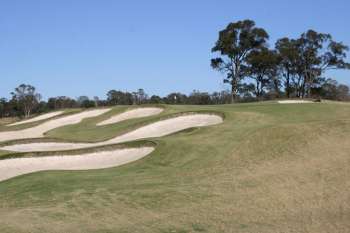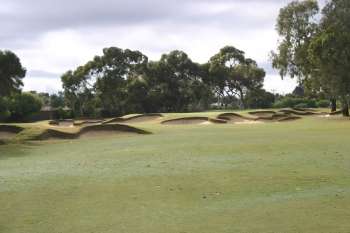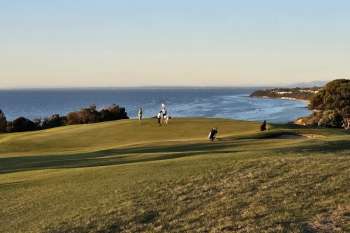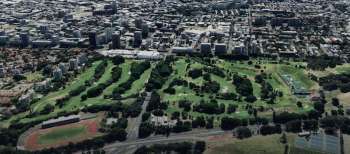Shark Sightings - two new Greg Norman courses open in Australia
Given the recent slowdown in golf construction across Australia, the opening of two new courses in quick succession has become a newsworthy event, especially when the courses are designed by the same company. Back in September the new East Course at the Grange Golf Club in Adelaide and Stonecutters Ridge on the western outskirts of Sydney were opened for play. Both carry the Greg Norman Golf Course Design signature.
While each course shares some obvious design parallels, the projects couldn’t have been more different. One, the redesign of an existing members layout, was completed in just two years while the other, which was part of a brand new residential subdivision, took closer to ten. Grange East was designed, conceived and built entirely by Greg Norman’s Florida based team, while Stonecutters was mostly created during Bob Harrison’s tenure as head of Norman’s Australian operations. Both are certain to be candidates for inclusion on our next Top 100 ranking list.
Stonecutters Ridge
For some time now Stonecutters Ridge has been marketed as the first Greg Norman golf course in Sydney. Part of a 160-hectare residential community that will eventually feature more than 800 home sites, the course is located close to Eastern Creek on a site that was a former chicken farm. The early holes here are built within a flat flood plain but the rest is set on rolling clay country with pleasant undulations and some attractive bushland.
Construction at Stonecutters began in 2008, but the genesis of the project dates back almost 10 years to when Medallist first negotiated the purchase of the site for the development of a new golf estate. As Bob Harrison explains, ‘in the early years the project was beset by a series of planning delays that related to protection of the creek, an extensive investigation of flooding to ensure that we maintained the flood capacity, the management of the flora and fauna, and a number of other statutory constraints. And then the global financial crisis hit.’ Harrison estimates that the final subdivision and golf course routing were his 21st or 22nd attempts to find the right balance needed to make the project both economically as well as environmentally viable.
What’s impressive about the Stonecutters subdivision is that only the 8th, 9th and 10th holes actually play through the houses. The rest of the holes have home sites set to one side, and in each instance the playing corridors are generous enough to prevent that awful over-crowding feeling you get on many estate layouts.
The shaping of the flatter areas is another highpoint, with the best holes arguably those on the front nine set within the flood plain. The dominant feature of this opening stretch is the constructed wetlands, which have been strategically incorporated into a number of interesting short and medium length par fours. The 3rd hole probably uses the wetlands best, its green is pressed right against the water and its fairway features a cleverly positioned Eucalyptus stump to complicate the approach shot. The 4th, 5th and 7th are short par fours that also use the wetlands reasonably well.
Once players walk off the 7th green they head under the main entrance road and into the more undulating countryside. While the bunkering on a handful of holes appears a little excessive, the landforms through this section of the course make for exciting golf and the par threes in particular carry a genuine aesthetic appeal. Most memorable is the short ridgeline-to-ridgeline 11th, which features a series of enormous bunkers cut into the underside of its target.
Interestingly, the 11th was the final hole built under the direct supervision of Bob Harrison, who left Greg Norman’s company in 2009 after more than 20 years in charge of his Australian design office. Construction of the remaining holes was overseen by Norman’s Florida team, who continued the theme of large-scale bunkering and broad playing corridors.
Norman describes Stonecutters as very ‘lay of the land’, and points out that ‘we really didn’t have to move a lot of earth to create the golf course.’ He adds that, ‘although the course is integrated into a residential development it has a core golf feel. We were fortunate to have a client that saw the benefits of making the golf course routing a priority.’
As for Harrison, he remains proud to have planned a good golf course in difficult circumstances but has some misgivings about a handful of green sites, which he says didn’t quite turn out the way he wanted. These include greens built under his watch, with the problem said to be a loss of key putting contours when the sand and gravel layers were constructed over the meticulously-shaped clay bases. Harrison is also disappointed that the 18th hole he designed as a par four was lengthened into a par five.
For members of the Ashlar Golf Club, who relocated to Stonecutters in September in a land swap deal with Medallist, such concerns are easily overlooked. Most are happily enjoying the superb condition of their new fairways and greens and testing themselves on holes that present a far greater challenge to their game than they are used to. One suspects that some of the more difficult holes will lose their appeal over time, but the club has managed to negotiate discounted fees for the first few years, which ought be enough to ensure the members enjoy their new home in the short term.
The Grange Golf Club - East Course
Another group of members enjoying a new and heartier test of golf are those from The Grange Golf Club in Adelaide. Unlike the somewhat protracted process of building Stonecutters Ridge, the redevelopment of the East Course here was undertaken with considerable speed. It was also the first project in Australia completed entirely under the supervision of Greg Norman’s American-based design team.
Back in mid-2010 Norman had announced the closure of his Sydney design office, and the centralisation of all future work to his Florida headquarters. Despite the loss of his local staff, and uncertainty about what clients could expect from this overseas team, within a month the company had been signed up to redesign The Grange’s East Course. For The Grange the appointment had obvious romantic appeal, given this was the scene of the Shark’s very first professional victory way back in 1976. Bringing Australia’s greatest golfing export back to the club in this way was certainly a coup, but one that carried a very clear risk. While the East Course was full of underwhelming holes, there were some safety issues in play and an unfortunate lack of space. For Norman’s team this was going to be a challenging project.
Like the West Course, the East at Grange was originally designed by Victorian Vern Morcom on a somewhat flat but sandy base. Prior to Norman’s appointment, Michael Clayton’s team had actually been engaged to redevelop the course as it had done previously on the West. Shortly after beginning work, however, the club had a rethink and decided to establish a clear point of difference between their two courses by engaging a different architect. The task handed to Norman and his senior designers was to transform the under-performing layout into something different and more dramatic. There is no doubt they succeeded.
Structurally Norman retained most of Morcom’s routing. The only significant changes were to convert the par five 4th into two short holes, and replace the old par three 8th and 16th holes with a short teaser at the 15th. This was done, in part, to ensure that both nines finished with a strong par five.
What wasn’t kept was the understated nature of the original Morcom holes, Norman instead preferring to overwhelm the lifeless landscape with a series of sprawling, flashy bunker complexes. These traps are clearly the standout feature of the new Grange East, and have injected life into a layout that previously lacked any real visual charm. The inspiration for the new design came from Melbourne’s Sandbelt courses, with Norman confirming that the sandy site made construction ‘more conducive to this (Sandbelt) style of bunkering’.
The greens are the other main talking point here. More subtly shaped than the sand traps, they feature plenty of stylish contours and are generally surrounded by interesting chipping zones. Norman says that he is ‘particularly proud of the set of greens we built on the East Course’, adding that ‘a lot of time was spent thinking about the rhythm for players as they progress through the round.’ He also noted that, ‘creating a unique strategy and identity for each hole is important but it’s also important to think about how the holes work together as a group.’
The credit for much of the greens shaping at Grange belongs to Norman associate Ryan VanDerVeen, who was on site during the entire project. One of the standouts is the almost drivable 4th, which has a wonderfully intricate target set obliquely to the fairway and complicated by a single hump on its left side and a shallow falloff on the right. With some softer bunkering and a broader landing area from the tee this hole would be brilliant. Also memorable are the aggressively bunkered 3rd, 13th and 15th holes and the steep false front on the long par five 7th.
Adrian Johnston, Captain at The Grange and chair of the club’s redesign working group, says the Greg Norman Golf Course Design team were terrific to work with and that the ‘members are really enjoying the challenges the new layout provides.’ Of the construction process, he adds that, ‘having ‘Ryan VanDerVeen on site for the entire project allowed us to discuss and problem solve with a designer in the field every step of the way. His attention to detail was first class.’
Aside from the occasional superfluity of bunkers, the only main concern here is the uncomfortably cramped area through the middle of the layout. Norman’s team did their best to open up the 10th, 11th and 18th fairways but the reality is that this section of the course is too tight for four holes and the designer’s hands were somewhat tied. They did reshape the 12th into an excellent long par three, but the fact that the 10th and 11th are narrow and still fall away to the outside of the dogleg is far from ideal.
For the majority of Grange members, however, there is no doubt that the redevelopment of their East Course will be a viewed a success. Whether Norman’s guys went overboard with the bunkering probably depends in part on your golfing tastes as well as your skill level, but the aim of the club to create a point of difference has certainly been achieved. Few visitors will leave here underwhelmed by the experience.
As for Norman himself, the opportunity to return to a course that helped launch his professional career brought back a lot of wonderful memories. ‘It’s a very special place for me’ said Norman of The Grange, ‘and I am thrilled that my design company was given the chance to renovate, reposition, and rebrand the East Course.’
Darius Oliver, Architecture Editor
Planet Golf review of Stonecutters Ridge
Planet Golf review of The Grange - East Course
Back to NewsMore News
Report reveals golf's $3.3 billion contribution to Australia
AGIC report reveals total annual benefits to the Australian community, economy and environment from golf.
Cape Wickham Links – The Inside Design Story
Co-designer Darius Oliver reveals the truth behind the design of Australia’s premier modern golf course
Have your say on the future of Moore Park Golf
Golfers unite – another one of our cherished public access golf courses is under threat
Cameron John wins The National Tournament by two strokes
Victorian claims breakthrough professional victory at The National Tournament presented by BMW





